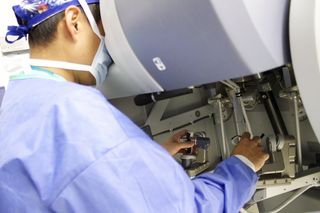 On his HLN show “Dr. Drew On Call,”Dr. Drew Pinsky, famous for sharing advice on sexual health, addiction, andother issues on his numerous TV shows, recently chronicled his journey withprostate cancer.
On his HLN show “Dr. Drew On Call,”Dr. Drew Pinsky, famous for sharing advice on sexual health, addiction, andother issues on his numerous TV shows, recently chronicled his journey withprostate cancer.
Drew’s story began with a prostate specificantigen (PSA) test, a urine check, and an ultrasound of his prostate. His doctor diagnosed prostatitis, or prostateinflammation, and followed up with a biopsy that found a low-grade tumor. Drewand his doctor pursued a plan of active surveillance and closely monitored thetumor for a year. Two additional biopsies reported that the mass on Drew’sprostate spread significantly enough to pursue a radical robotic prostatectomy.
Drew nowsays on HLN that he is cancer free.
Similar prostatecancer cases are routine for Penn Medicine urologists David I. Lee, MD, chiefof the division of Urology at Penn Presbyterian Medical Center, PhillipMucksavage, MD, assistant professor at Pennsylvania Hospital, and Thomas J.Guzzo MD, MPH, assistant professor at the Hospital of the University ofPennsylvania, who perform this procedure and many other robotic surgerytechniques for urological problems. Together, they comprise the Philadelphiaarea’s most experienced robotic urologic surgery team.
All prostatecancer patients are unique and have numerous treatment options – which, inaddition to robotic prostatectomy, also include traditional open surgery,conventional radiation treatment or proton beam therapy, drug therapy, or even"watchful waiting," in which patients are monitored closely in lieuof undergoing any treatment.
I asked these experienced urologists howpatients can sort through their options and decide what approach is best forthem, especially as robotic surgery procedures proliferate and are offered bymore hospitals.
Whenapproached by a patient seeking a prostatectomy, the doctors say that aurologist should be comfortable sharing the difference between robotic andlaparoscopic prostatectomy.
“Thebenefit of the robotic approach is the wristed instruments which allow for manydegrees of freedom as opposed to the rigid laparoscopic instruments,” saidGuzzo. “This is particularly advantageous in prostate surgery due to thespace constraints of the pelvis. The wristed instruments allow the surgeon tomaneuver in the pelvis much more effectively and efficiently.”
Experience using the robotic procedure shouldbe a key quest for men interested in that option, Lee says.
“The more experience the surgeon has withtheir particular approach, the better the results are,” said Lee, who hasperformed more than 3,700 robotic prostatectomies. “However, once that criterionis met, then a discussion about the benefits of a particular approach is thenappropriate.”
The benefits of robotic prostatectomy caninclude quicker recovery from surgery, including less pain, less blood loss,shorter hospital stay, shorter time with a urinary catheter and a quickerreturn to work and exercise. But Leeadds that the primary outcomes, such as cancer cure percentages, recovery ofurinary control and erection function are dependent not on use of the robot,but on the surgeon’s experience.
The procedure, like any surgery, can comewith side effects, however.
“The two most noteworthy potential long termconsequences of the operation include urinary leakage and erectiledysfunction,” Mucksavage says. “It is rare, but some men will require a procedurein the future to improve their continence after surgery.”
Mostmen experience little to no leaking after the procedure, and some men who hadurinary issues due to a large obstructing prostate before the operation mayactually see an improvement after the surgery.
Patientsalso have choices for treating any possible erectile dysfunction after thesurgery.
“Arobotic prostatectomy won’t improve erections, but most men who could achievean erection before should be able to do so after the surgery,” added Guzzo.“Patients have options to assist them in regaining this function, includingoral medications. At Penn, we also have an aggressive post-surgicalrehabilitation program focusing on quality of life after prostate surgery.”
The Penn team is continuing their work toimprove outcomes associated with robotic surgery, including the recent completionof a pilot study with Penn Engineering that incorporates haptic, or a sense of touch, technology torobotic minimally invasive surgery.
Current robotic technology provides no audioor vibration feedback to the surgeon when touching rougher surfaces or specificbody parts, which may impact efforts to spare nerves during these procedures.The new haptic feature – similar to that which is used on smart phone keyboards – provides additional clues for what’s happening in the body duringsurgery, assists in training residents, improves surgeon awareness whenoperating, and gives feedback even when robotic arms are off camera.